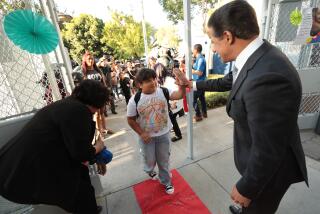Give Students Books Before Bytes
- Share via
Imagine that you are the ruler of a developing country plagued by infectious diseases. You are given two choices to help save your people. Option 1 is to buy a state-of-the-art, ultrasophisticated CAT scan machine for your national hospital. Option 2 is to improve public sanitation by digging sewers for every village.
Option 1 will save the lives of maybe a few dozen people a year, but will make you look like a modern, cosmopolitan head of state. Option 2 will save hundreds of thousands of lives a year, but will strike many as rather boring and routine.
Which would you choose?
Now consider the plight of California’s schools. Confronted with some of the worst reading scores in the country, schools are faced with two options. The first is to spend millions of dollars on computers, Internet connections and sophisticated technology. The second is to stock an aging, pitiful school library system with new books and magazines.
Guess which option can save the most students from academic catastrophe. Guess which option the governor, the Legislature and most schools have chosen. Despite the appeal of computers, research thus far has found that their impact on reading achievement is decidedly weak. In fact, in a series of studies conducted at the University of Southern California, school libraries were found to have a much stronger influence on reading scores than any of the factors now touted as being critical to success in reading, including the number of computers, class size and the amount of phonics instruction.
So how does California fare in libraries? In a word, dismally. The book collections are out of date, tattered and completely inadequate for the state’s 5 million schoolchildren. In some libraries, there still are books that speak of how, some day, we will send a rocket to the moon.
Nationally, California ranks 45th in per pupil library expenditures, 49th in the number of books per student and 50th in the ratio of librarians to students. The recommended number of books per student in the school library is 20 to 1; in California, it’s under 10 to 1 and in many urban districts it’s as low as 3 to 1. As for librarians, the average per pupil ratio in the U.S. is 895 to 1; in California, it’s 5,496 to 1.
For kids who come from upper- and middle-income families, this is not a problem. Most of them already have access to books--lots of books--at home, and attend select schools that have well-stocked libraries.
But for the one child out of every four in California who lives in poverty, school is often the only place to find books to read. Sitting in front of a computer screen for 10 minutes a day is no substitute. Technology is still a long way from being able to meet the ease, portability and variety of printed books. Paperbacks must come before hard drives.
Of course, it would be wonderful if we could afford both more books and more computers. But the realities of school funding in most districts are otherwise. There is simply not enough money allocated to restock school libraries and hook up every classroom to the Information Highway.
The lure of computers is almost irresistible for schools, parents and especially politicians. But first things first. The Internet can wait.






